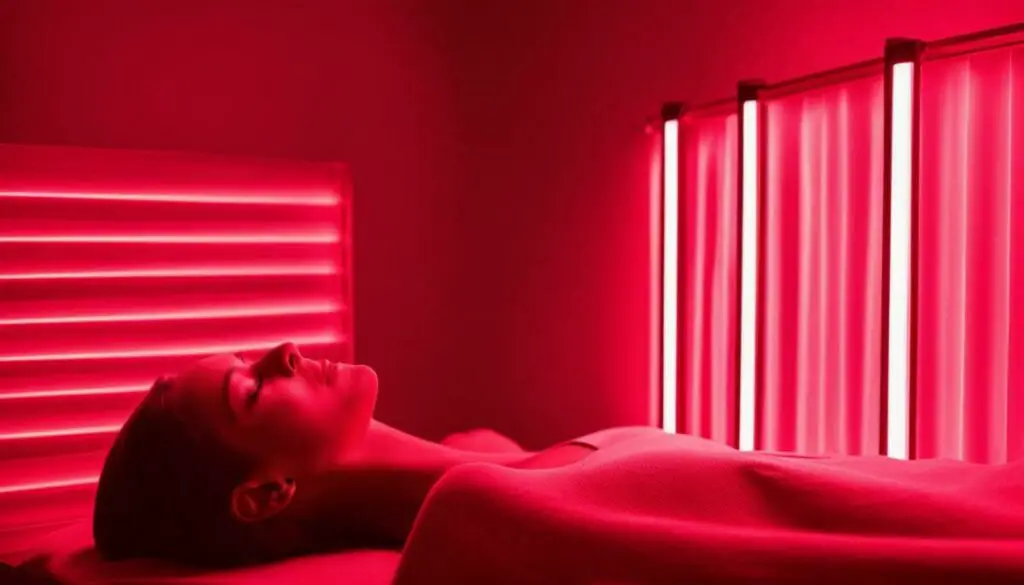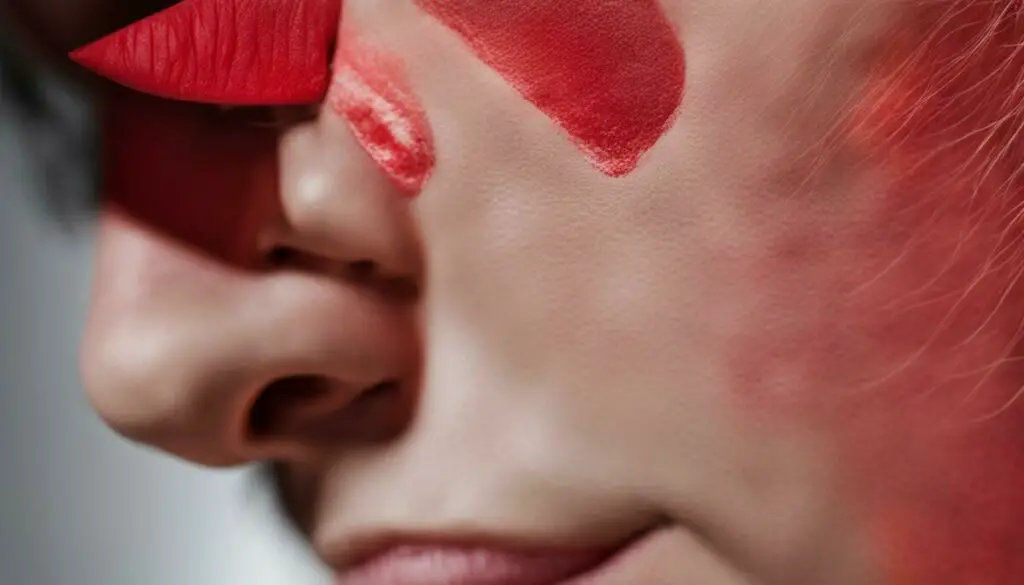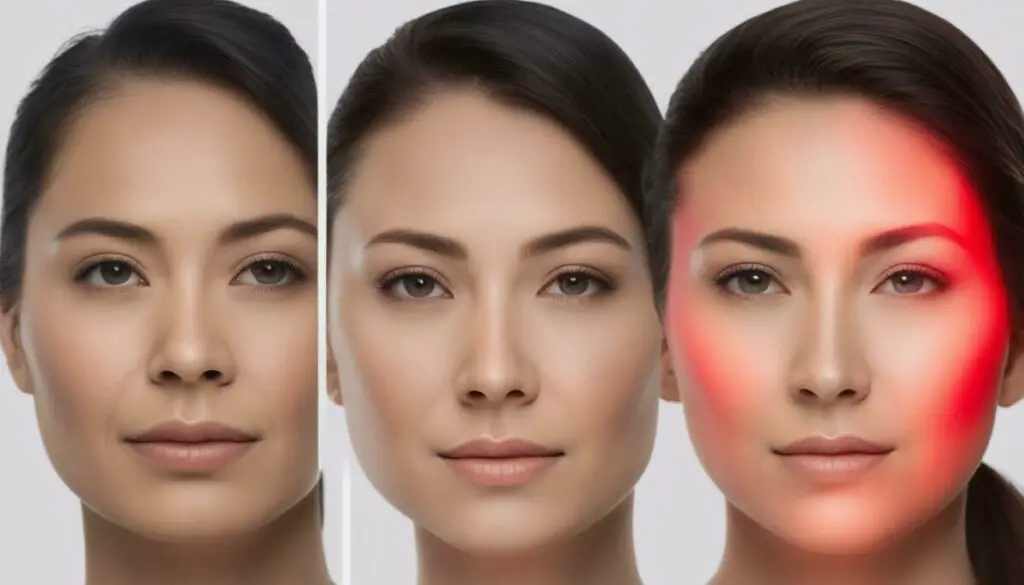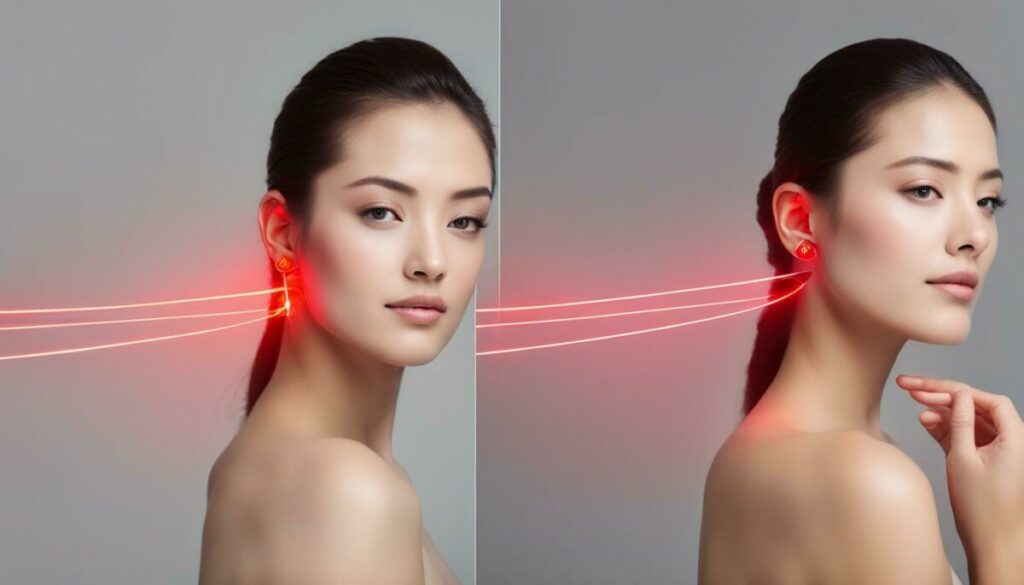Last Updated on 7 months by Francis
Are you considering HIFU or Red Light Therapy for your skincare needs? These two treatments are becoming increasingly popular due to their ability to improve the appearance and overall health of the skin. However, it can be challenging to determine which option is best suited for your needs.
In this article, we will explore the differences between HIFU (High-Intensity Focused Ultrasound) and Red Light Therapy. We’ll examine the benefits of Red Light Therapy and dive into the specifics of HIFU treatment, allowing you to make an informed decision about which option is best for you and your skincare goals.
Contents
Key Takeaways
- HIFU and Red Light Therapy are both popular treatments for improving skin health and appearance.
- HIFU uses high-intensity ultrasound waves to penetrate deep layers of the skin, while Red Light Therapy utilizes specific wavelengths of light to stimulate cell growth and repair.
- HIFU is effective for addressing deep wrinkles and sagging skin, while Red Light Therapy can improve skin texture, tone, and elasticity.
- It’s important to consider the cost, potential side effects, and treatment process when deciding between HIFU and Red Light Therapy.
- Real user experiences and testimonials can provide valuable insights into the effectiveness and satisfaction levels of each treatment.
What is HIFU?
If you are looking for a non-invasive and effective treatment to improve your skin’s appearance, HIFU might be just what you need. HIFU stands for High-Intensity Focused Ultrasound, a cutting-edge technology that uses ultrasound waves to heat up the deep layers of your skin, promoting collagen production and tightening your skin.
HIFU is a popular treatment choice for those seeking to achieve tighter, more youthful-looking skin without undergoing surgery. Compared to other skin rejuvenation treatments, HIFU is considered to be less invasive and requires less downtime.
How does HIFU work?
HIFU uses ultrasound energy to create microscopic “points of trauma” in the deep layers of your skin. These microtraumas stimulate your body’s natural healing response, producing new collagen and elastin fibers that help tighten and firm up your skin. The ultrasound waves are delivered via a handheld wand that is passed over the target area.
One of the significant advantages of HIFU is its ability to deliver highly targeted energy to specific areas of the skin. This makes it an effective treatment for addressing sagging skin, fine lines, and wrinkles on the face, neck, and chest.
Types of HIFU machines
There are various types of HIFU machines available on the market, each with its unique features and benefits. Some of the most popular HIFU machines include:
| Machine | Brand | Benefits |
|---|---|---|
| HIFU Ultraformer III | Classys | Can deliver precise energy to deeper layers of the skin with minimal discomfort |
| HIFU Regen | Dr. Arrivo | Can target multiple depths of the skin, providing customized treatment options |
| Ultraformer | Classys | Offers fast and effective treatments with minimal downtime |
When considering HIFU treatment, it’s essential to do your research and select a qualified practitioner that uses a reputable machine.

Now that we’ve covered the basics of HIFU, let’s explore the benefits of red light therapy in the next section.
Understanding Red Light Therapy
Red light therapy has been gaining popularity in recent years as a non-invasive treatment option for a variety of skin concerns. This therapy involves exposing the skin to low levels of red or near-infrared light, which penetrates deep into the skin’s layers, stimulating cellular repair and regeneration.
One of the most significant benefits of red light therapy is its potential to improve the appearance of the skin. By stimulating collagen production, this therapy can help reduce the appearance of fine lines, wrinkles, and other signs of aging. Red light therapy can also improve the skin’s texture, tone, and elasticity, resulting in a smoother, more youthful complexion.
Research has also shown that red light therapy can be effective in addressing various skin concerns, including acne, rosacea, and psoriasis. This therapy can help reduce inflammation, redness, and irritation, promoting healing and preventing future breakouts.
Moreover, red light therapy is a non-invasive and painless treatment option, which is safe for most skin types. Unlike other skin treatments, red light therapy does not cause any damage to the skin’s surface, making it an ideal option for individuals who want to avoid invasive procedures.

Overall, red light therapy is an effective and safe treatment option, which can improve the skin’s appearance and address various skin concerns. Whether you want to reduce the appearance of wrinkles or improve the overall health of your skin, red light therapy may be an excellent choice for you.
Comparing Skin Benefits
Both HIFU and red light therapy offer distinct advantages when it comes to skin care. HIFU facials are designed to penetrate deep layers of the skin, stimulating collagen production and promoting skin tightening. On the other hand, red light therapy has been shown to improve the texture, tone, and elasticity of the skin, reducing the appearance of wrinkles.
If you’re looking for a treatment that specifically targets fine lines and wrinkles, red light therapy may be the better option for you. This non-invasive treatment uses low-level wavelengths of light to stimulate the production of collagen and elastin in the skin, resulting in a more youthful and radiant appearance.
However, if you’re looking to address more significant skin laxity, HIFU may be the way to go. By using high-intensity focused ultrasound energy to target deep layers of the skin, this treatment can produce significant tightening and lifting effects, resulting in a more defined and contoured facial appearance.
| HIFU Facial | Red Light Therapy for Skin |
|---|---|
|
|
Ultimately, the choice between HIFU and red light therapy will depend on your specific skin concerns and desired outcomes. Consult with a qualified practitioner to determine which treatment is best for you.

Wellness Benefits
Both HIFU and red light therapy offer a range of wellness benefits beyond improving the appearance of the skin. Red light therapy, for instance, has been found to reduce inflammation and joint pain, making it an effective treatment option for those with arthritis or other chronic pain conditions. It can also boost the immune system and improve circulation, aiding in overall recovery and healing.
On the other hand, HIFU therapy can also address pain relief and promote relaxation. However, the cost of HIFU treatments may be higher than that of red light therapy, making it less accessible for some individuals.
When considering the wellness benefits of both HIFU and red light therapy, it is crucial to weigh the potential benefits against the cost and accessibility of each treatment.

Side Effects and Risks
While HIFU is generally safe, some patients may experience side effects after treatment. The most common side effects include:
- Pain or discomfort: Some patients may feel slight pain or discomfort during the treatment, which can be managed with over-the-counter pain medication.
- Redness or swelling: Patients may experience mild redness or swelling in the treated areas, which usually subsides within a few hours.
- Tingling or numbness: Tingling or numbness may occur in the treated areas immediately after the treatment but usually resolves within a few days.
- Bruising: Bruising may occur in some patients, especially those with sensitive skin. However, this usually subsides within a week.
It’s important to note that serious side effects from HIFU are rare. However, in some cases, patients may experience:
- Burns: In rare cases, patients may experience burns from the ultrasound energy. This is more common in patients with thin skin or those who have been exposed to high levels of sun or radiation.
- Nerve damage: In very rare cases, HIFU can damage the nerves in the treated area, leading to numbness or weakness.
- Scarring: While rare, some patients may experience scarring in the treated areas.
To minimize the risk of side effects, it’s important to choose a qualified practitioner who is experienced in performing HIFU treatments. You should also inform your practitioner of any medical conditions or medications you are taking, as this may increase the risk of side effects.

Safety and Non-Invasiveness
When it comes to choosing a skincare treatment, safety and non-invasiveness are essential considerations. HIFU and red light therapy are both non-invasive treatments, meaning they do not require any incisions or injections, and patients can typically return to their daily activities immediately following treatment.
However, HIFU is known to cause more discomfort during the treatment process than red light therapy. Patients may experience a warm or prickling sensation during HIFU treatment, whereas red light therapy is generally pain-free and relaxing.
It’s important to note that both treatments have minimal risks and side effects. Red light therapy has no known side effects, while HIFU treatment may cause minor redness, swelling, or tenderness in the treated area.
Overall, while both treatments are safe and non-invasive, red light therapy may be a more comfortable option for those who prioritize a pain-free, relaxing treatment experience.

Targeted Areas of Treatment
Both HIFU and red light therapy can target specific areas of the body or face to address pain relief, body contouring, and cosmetic concerns. However, the targeted areas of treatment for each therapy differ based on their technology.
| HIFU | Red Light Therapy |
|---|---|
| HIFU can target deep layers of the skin, making it effective for lifting and tightening sagging skin on the face, neck, and décolletage. It can also be used for body contouring, targeting the abdomen, thighs, and arms. | Red light therapy can improve the appearance of the skin on various parts of the body, including the face, neck, hands, and back. It can also provide pain relief for joints and muscles. |

While both therapies offer targeted treatment options, it’s important to consider which areas are most important to you when deciding between HIFU and red light therapy.
Treatment Process and Duration
Both HIFU and red light therapy treatments require a series of sessions for optimal results. The number of sessions may vary depending on the individual’s specific skin concerns and goals.
During an HIFU treatment, the practitioner will apply a handheld device to the targeted area, emitting high-frequency ultrasound waves that penetrate deep into the skin. The procedure can take anywhere from 30 minutes to 2 hours, depending on the size of the area being treated. Some individuals may experience slight discomfort during the treatment, but this typically subsides once the session is complete.
Red light therapy, on the other hand, is generally a shorter and less invasive treatment. The practitioner will apply a low-level laser or LED light to the skin, which penetrates the surface to stimulate collagen production and improve cell function. A session typically lasts between 10-30 minutes, and most individuals report feeling no discomfort during the treatment.

For both treatments, maintenance sessions may be required to sustain the results. It is important to consult with a qualified practitioner to determine the best treatment plan for your specific needs.
Section 10: Understanding the Results
When deciding between HIFU and red light therapy, understanding the expected results is crucial. While both treatments have their unique benefits, the results can vary depending on the individual’s skin type, concerns, and overall health.
Red light therapy benefits: Red light therapy is known for improving the texture, tone, and elasticity of the skin. This treatment can stimulate collagen production, reducing the appearance of fine lines and wrinkles. With regular sessions, red light therapy can also improve skin hydration and reduce inflammation, making it an excellent option for those with acne-prone or sensitive skin.
HIFU treatment comparison: HIFU is specifically designed to target deep layers of the skin, providing a more dramatic improvement in skin laxity and contouring. This treatment is often used for facial tightening and lifting, reducing the appearance of sagging skin around the cheeks, jawline, and neck. However, HIFU treatment may require multiple sessions to achieve optimal results.
Both HIFU and red light therapy can provide long-lasting results, with maintenance sessions recommended to sustain the benefits. It’s essential to discuss your skincare concerns and goals with a qualified practitioner to determine the best treatment option for you.

Understanding the Timeline
The timeline for seeing noticeable improvements can vary depending on the treatment and individual’s skin type. Red light therapy typically requires 8-10 sessions to see maximum benefits. Improvement in skin texture and tone can be seen after just a few sessions, while a reduction in fine lines and wrinkles may take longer.
HIFU treatment also requires multiple sessions, with results becoming more apparent after each session. Optimal results are typically seen 2-3 months after the final session, with the benefits lasting for up to a year or more.
Maintenance Requirements
Red light therapy benefits: Maintenance sessions are recommended every 4-6 weeks to sustain the benefits of red light therapy. Consistent treatment can help to maintain collagen production and reduce the appearance of fine lines and wrinkles, improving the overall texture and tone of the skin.
HIFU treatment comparison: Maintenance sessions for HIFU treatment may vary depending on the individual’s skin concerns and initial results. Some individuals may benefit from annual sessions, while others may require more frequent maintenance. It’s important to discuss your options with a qualified practitioner to determine the most effective maintenance plan for you.
Overall, both HIFU and red light therapy can provide significant benefits for improving skin appearance and overall wellness. Choosing the right treatment option comes down to your individual needs and goals. Consider consulting with a skincare professional to discuss your options and create a personalized treatment plan.
Factors to Consider
When deciding between HIFU and red light therapy, there are several important factors to consider. One of the most significant factors is the cost of the treatment. While the cost of HIFU therapy can vary depending on the provider and the area being treated, it is generally more expensive than red light therapy.
However, it is important to note that the cost of HIFU therapy may be worth it for individuals who are looking for more dramatic results or are dealing with more severe skin concerns. Additionally, some clinics may offer financing options or package deals that can help make HIFU therapy more affordable.
Another factor to consider is the availability of qualified practitioners. HIFU therapy is a more advanced treatment that requires specialized training and experience. It is important to research and choose a reputable provider with extensive experience in performing HIFU treatments.
Lastly, it is important to consider any other factors that may influence your decision, such as your overall skincare goals, the specific areas you want to target, and any personal preferences you may have.

Ultimately, the decision between HIFU and red light therapy will depend on your individual needs and goals. By carefully weighing the factors discussed in this article, you can make an informed decision that will help you achieve your desired results and improve your overall wellness.
Real User Experiences
HIFU and red light therapy have gained popularity in recent years for their skin rejuvenation and other wellness benefits. Many individuals have shared their experiences and opinions on the effectiveness and overall satisfaction of these treatments.
Cost is one of the main factors that individuals consider when deciding between HIFU and red light therapy. Some users have reported that the cost of HIFU therapy is higher than red light therapy, and may require multiple sessions for optimal results. However, others have found the cost of HIFU therapy to be worth the investment due to the depth of treatment provided.
One user noted that they were initially hesitant to try HIFU due to the cost, but after seeing a noticeable improvement in their skin texture and firmness, they were pleased with the results and felt it was worth the investment.
On the other hand, red light therapy has been praised for its affordability and accessibility. Users have reported significant improvements in their skin tone and reduction in wrinkles after consistent treatment.
Overall, cost may be a significant factor in the decision-making process for some individuals. However, it is important to consider the effectiveness and potential results of each treatment when making a decision.

“After seeing a noticeable improvement in their skin texture and firmness, they were pleased with the results and felt it was worth the investment.”
Conclusion
After comparing HIFU and Red Light Therapy, we hope you have a better understanding of the benefits and differences of each treatment. HIFU offers deep skin penetration and can effectively target specific areas for body contouring and facial rejuvenation. On the other hand, Red Light Therapy is non-invasive, safe, and can improve skin texture, tone, and elasticity.
When it comes to wellness benefits, both HIFU and Red Light Therapy offer potential pain relief and improved circulation. HIFU treatment may require a longer recovery time and a higher cost than Red Light Therapy, but it is important to note that both treatments require multiple sessions for optimal results.
Ultimately, the decision between HIFU and Red Light Therapy will depend on your skincare needs and wellness goals. We highly recommend consulting with a qualified practitioner to discuss which treatment is best suited for you.
Choose the Best Option
Whether you choose HIFU or Red Light Therapy, it is essential to remember that each treatment is unique and offers its benefits. Take the time to consider the factors mentioned in this article, such including the cost, potential side effects, and targeted areas of the body. By doing so, you will most likely make an informed decision about which treatment to pursue.
Thank you for reading our comparison of HIFU vs Red Light Therapy. We hope you found this article informative and helpful.
FAQ
What is HIFU?
HIFU stands for High-Intensity Focused Ultrasound. It is a non-invasive procedure that uses ultrasound energy to lift and tighten the skin.
What is Red Light Therapy?
Red light therapy is a non-invasive treatment that uses low-level red light wavelengths to promote skin rejuvenation and improve various skin concerns.
How does HIFU work?
HIFU works by delivering focused ultrasound energy to the deeper layers of the skin, stimulating collagen production and resulting in skin tightening and lifting.
How does Red Light Therapy work?
Red light therapy works by penetrating the skin with red light wavelengths, which can stimulate the production of collagen, improve blood circulation, and enhance cellular function.
What are the skin benefits of HIFU?
HIFU can improve the appearance of sagging skin, reduce wrinkles and fine lines, and enhance overall skin tightness and firmness.
What are the skin benefits of Red Light Therapy?
Red light therapy can help improve the texture, tone, and elasticity of the skin, reduce the appearance of wrinkles, and promote a more youthful and radiant complexion.
Are there any side effects of HIFU?
Common side effects of HIFU may include temporary redness, swelling, and mild discomfort in the treated area. These usually subside within a few hours to a few days.
Is HIFU treatment safe?
HIFU treatment has been proven to be safe when performed by a qualified professional. However, it is important to consult with a healthcare provider to ensure it is suitable for your specific needs.
Is Red Light Therapy painful?
Red light therapy is a painless and non-invasive treatment. It does not cause any discomfort or require any downtime.
Can HIFU and Red Light Therapy be used on different body areas?
Yes, both HIFU and Red Light Therapy can be used on various areas of the body, including the face, neck, abdomen, arms, and thighs.
How long does a HIFU treatment session take?
The duration of a HIFU treatment session can vary depending on the area being treated. Generally, it can take anywhere from 30 minutes to 2 hours.
How long does a Red Light Therapy session take?
A Red Light Therapy session typically lasts around 10 to 20 minutes, depending on the treatment area and the specific device being used.
When will I see results from HIFU?
Results from HIFU can be noticeable immediately after the treatment, with continued improvement over the following weeks as collagen production is stimulated.
When will I see results from Red Light Therapy?
Results from Red Light Therapy may vary, but many individuals start noticing improvements in their skin’s appearance within a few weeks of starting the treatment.
How much does HIFU therapy cost?
The cost of HIFU therapy can vary depending on the location, the area being treated, and the number of sessions required. It is best to consult with a provider for specific pricing information.
Are there any real user experiences for HIFU and Red Light Therapy?
Yes, many individuals have shared their experiences and testimonials regarding their satisfaction with both HIFU and Red Light Therapy. It can be helpful to research and read reviews to gain insights from actual users.


.jpg)






